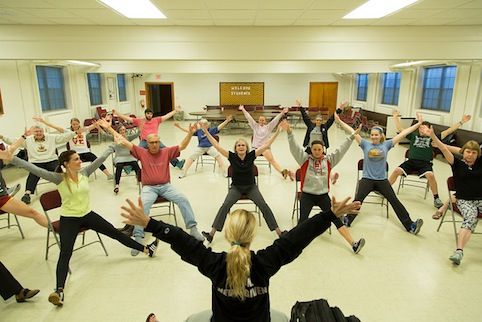Ballroom dancing helps those with Parkinson’s disease

ISU’s Department of Kinesiology hosts a music and movement outreach program which aims to keep bodies active after being affected by Parkinson’s disease.
November 18, 2015
Up and down, up and down.
This is one pair of motions that people with Parkinson’s disease accomplish with help from the music and movement outreach program run by the department of kinesiology.
The program uses music therapy, stretching, exercise and ballroom dancing to help participants keep their bodies up to par despite the debilitating effects of Parkinson’s disease.
“The goal is to provide those with Parkinson’s disease to move and exercise,” said Elizabeth Stegemoller, assistant professor of kinesiology. “The best thing we do is music because it’s specifically tailored.”
Stegemoller plays the piano during the sessions and tailors the music to the participant’s preferences. The music also has simple lyrics and typically goes in rhythm with whatever exercise is taking place.
A typical program includes six to eight participants with 18 student helpers. The program begins with stretching and moves onto seated exercises that force large movements. During the exercise portion, participants sing along with the music.
Ballroom dancing is the another portion of the program, and participants are encouraged to talk with their student partner instead of sing. Ballroom dancing helps counteract several effects of Parkinson’s disease by improving participants’ posture and balance.
“The interaction between students and the people with Parkinson’s disease gets me a little teary-eyed,” Stegemoller said. “To just listen to them talk with each other and ask, ‘How’s your granddaughter?’ and ‘How did you do on that test last week?’ — showing support for each other is really a neat thing.”
Stegemoller had already implemented a singing program for those with Parkinson’s disease when she started getting questions about a music program for those suffering from the disease.
Stegemoller then approached Ann Smiley-Oyen, associate professor of kinesiology, about starting a program in Ames with the help of one of Stegemoller’s students, Alison Brinkman, senior in kinesiology and health.
Brinkman said she was doing research for Stegemoller a year and a half ago when Stegemoller asked what she was interested in. Brinkman was interested in dance, and Stegemoller thought it would be a great idea to include Brinkman in the program.
Brinkman choreographs routines for the program and includes holiday specials. Around Halloween, Brinkman taught the participants the moves to Michael Jackson’s “Thriller” and is currently teaching participants the choreography for a holiday routine.
The music and movement program is having a holiday extravaganza for the participants to show off to their friends and family everything they have learned through the program.
Brinkman said that she gets joy from seeing participants succeed.
“The biggest thing I get out of this program is helping others succeed. It really brings me joy seeing people with smiles on their faces and doing things they couldn’t do,” Brinkman said.
People who want to participate in the music and movement program are encouraged to call Stegemoller for more information at 515-294-5966. Walk-ins are also welcome.
The program takes place every Tuesday evening from 4 to 5 p.m. at the First Baptist Church in Ames.







Catherine Roberta | Dec 21, 2022 at 4:55 am
I was diagnosed 2011. i was diagnosed with Parkinson’s disease. My symptoms progressed quickly. Soon i was having difficulty breathing, swallowing and even walking short distances. With the help of Health Herbs Clinic natural herbs I have been able to reverse my symptoms using diet, herbs, which i feel has made the most difference. The Parkinson’s natural formula immensely helped my condition, it reversed my Parkinson’s. my slurred speech, then the tremors, and mobility gradually disappeared, even my handwriting is getting better visit their website at healthherbsclinic people are suffering from this horrible disease due to lack of information.